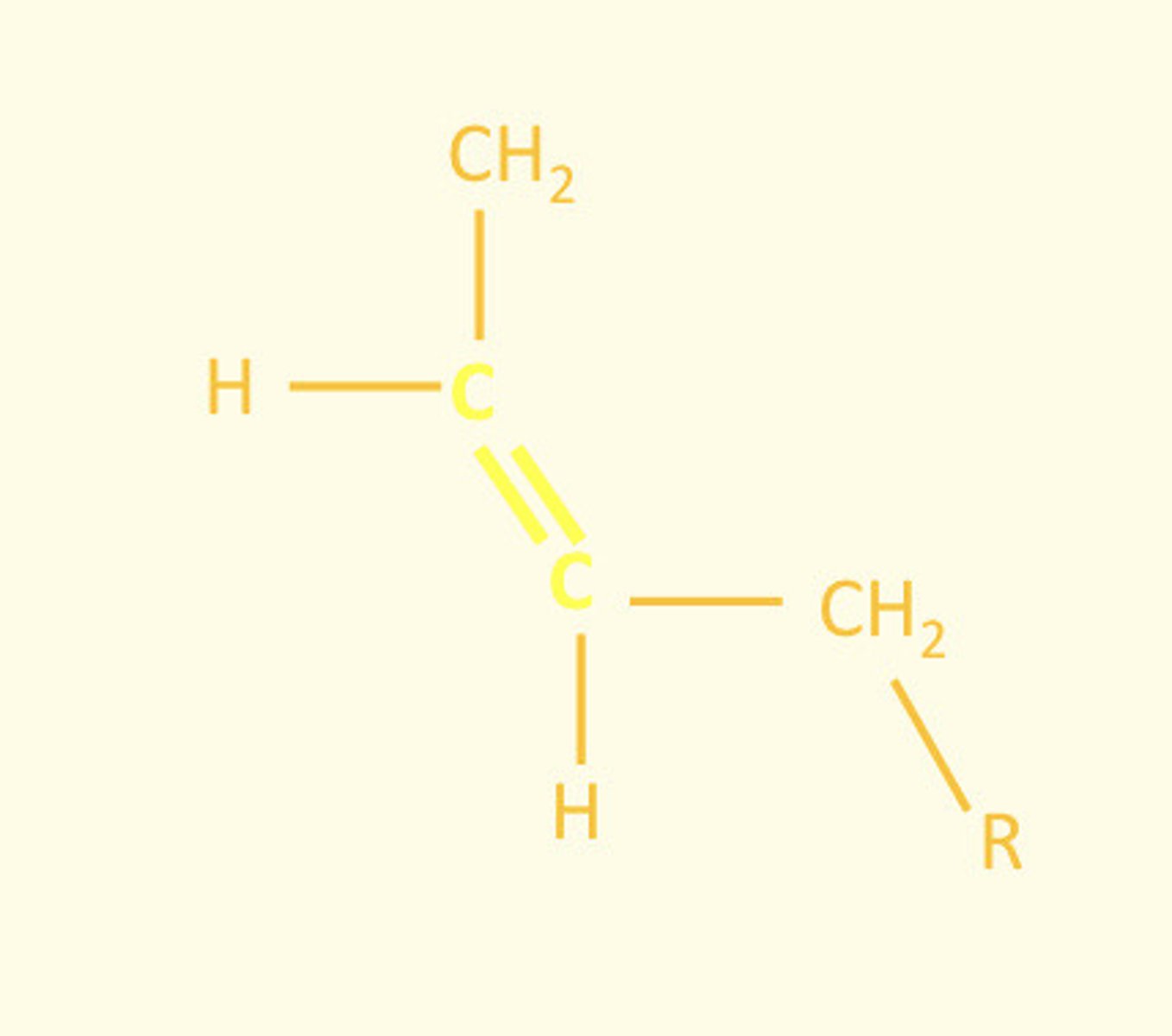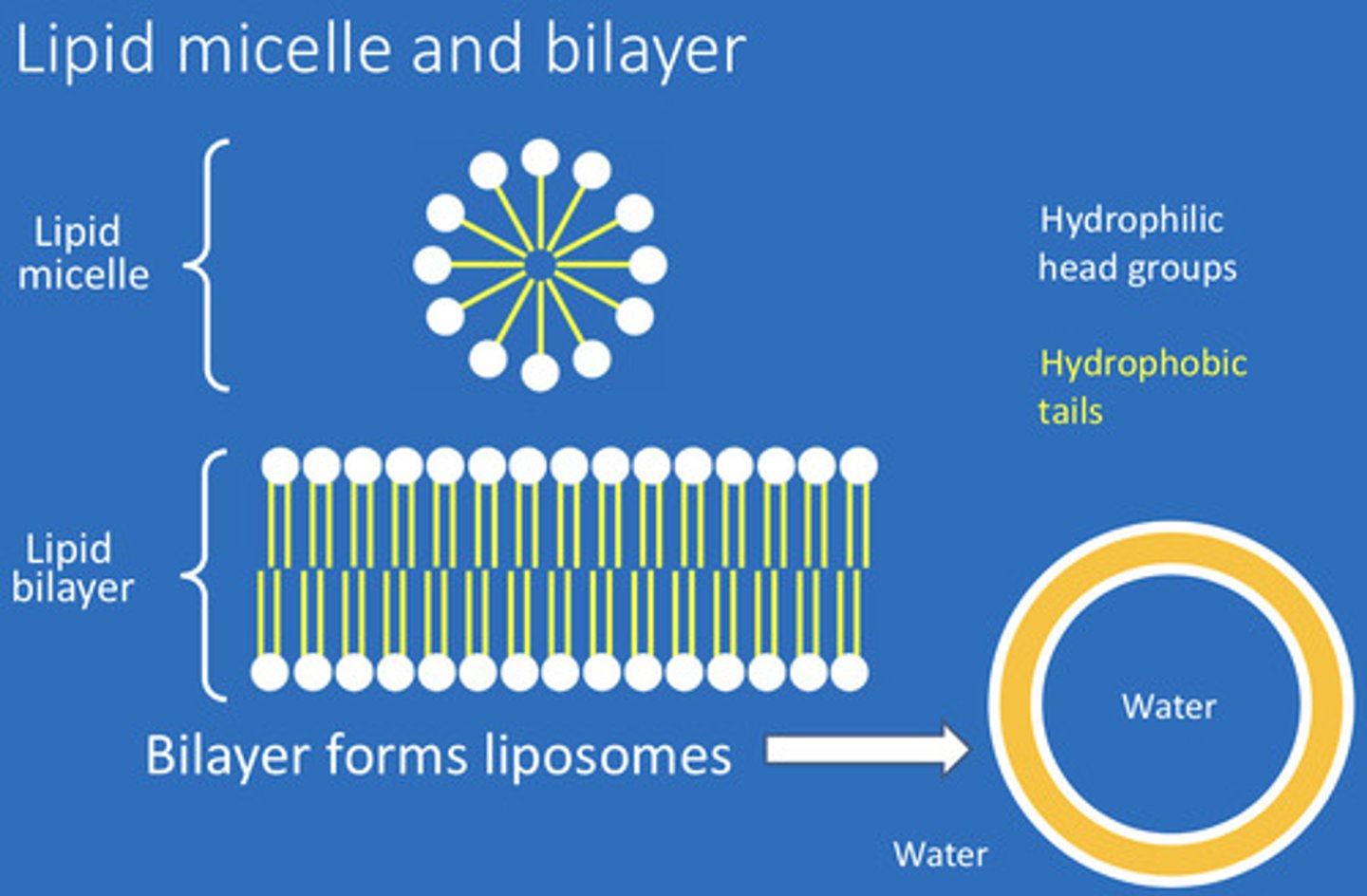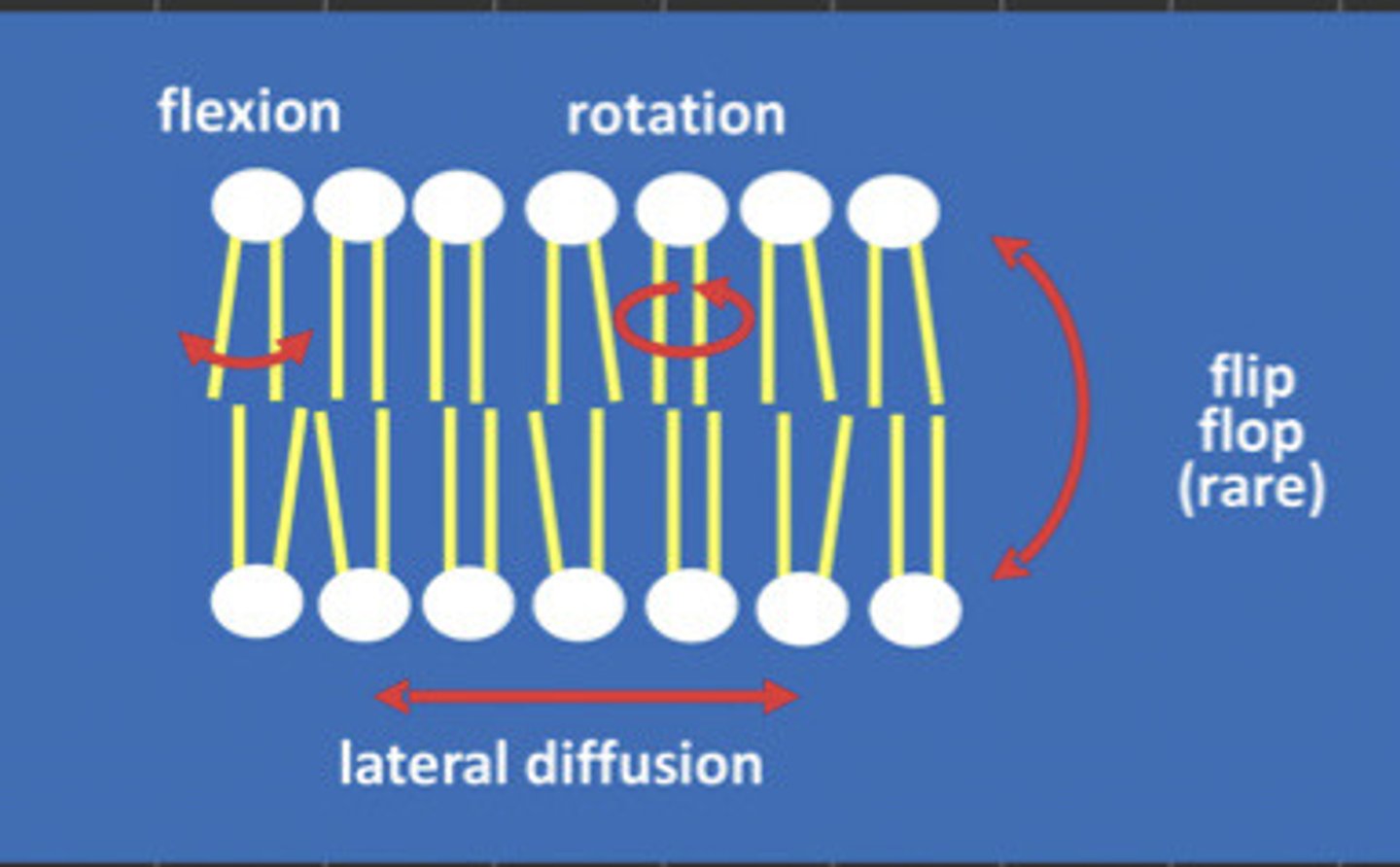Session 5: Cell Membranes
1/94
There's no tags or description
Looks like no tags are added yet.
Name | Mastery | Learn | Test | Matching | Spaced |
|---|
No study sessions yet.
95 Terms
What are the functions of the biological membrane?
- Form a continuous & highly selective permeability barrier
- Allow control of enclosed chemical environment
- Allow communication between cell & environment
- Generate signals in response to electrical & chemical stimuli
What does 'amphipathic' molecules mean?
Molecules that contain both a hydrophilic and hydrophobic group
What are phospholipids composed of?
glycerol, 2 fatty acids, a phosphate group, and a polar 'head group'
What are some examples of phospholipid polar head groups?
Choline, amines, amino acids, sugars
What is the most prevalent length of fatty acid chains?
C16 and C18 length
The ___ double bond introduces a kink into the structure of the fatty acid chains
The cis double bond introduces a kink into the structure of the fatty acid chains

What is the range of length for fatty acid chains?
C14 to C24
What is the predominant class of lipids in cell membranes?
Phospholipids
What is Sphingomyelin?
ceramide + phosphate + choline
It is an example of a glycolipid
Glycolipids
Sphingomyelin, Cerebrosides, Gangliosides
What is the head group of cerebrosides?
Sugar monomer head group
What is the head group of gangliosides?
Oligosaccharide head group
Approximately how much of the membrane lipid does cholesterol comprise?
~45%
What is the role of cholesterol in the membrane?
Help modulate membrane fluidity under physiological conditions
What two structures do amphipathic molecules produce in aqueous solution?
Micelles and bilayer (preference to form bilayer)

What is an 'unsaturated' fatty acid?
Fatty acid that contains a double bond in the cis conformation
How does the presence of a double bond affect membrane fluidity in phospholipids?
Reduces phospholipid packing and therefore affects membrane fluidity
What structure do amphipathic molecules such as glycolipids and phospholipids prefer to produce in aqueous solution?
Bilayers
What force drives the formation of lipid bilayers?
Van der Waals forces between hydrophobic tails
The cooperative structure of membranes is stabilised by non-covalent forces, electrostatic attraction and ___ bonding between hydrophilic moieties and interactions of hydrophilic groups and water
hydrogen bonding
What are the four modes of phospholipid motion in membranes?
- Intra-chain motion = kink formation in the fatty acyl chains
- Fast axial rotation
- Fast lateral diffusion
- Flip-flop = movement of lipid molecules from one half of bilayer to the other half on a one for one exchange basis

What are other factors affect the fluidity of the lipid bilayer?
- Unsaturated cis double bonds produce ‘kinks’ = reduce phospholipid packing and increase fluidity
- Cholesterol = stabilises the membrane fluidity
What is the function of membrane proteins?
Transporters - control movement across membrane
Anchors - attachment points to the membrane
Recognition - markers for cell-cell interaction
Glue - junctions connecting cells
Enzymes - localising metabolic pathways
Transduction - receptors carry signals into the cell
What are the two types of membrane protein?
integral and peripheral
What are the three modes of protein motion?
1) Conformational change
2) Rotational
3) Lateral movement
What motion found in lipid motion is absent in protein motion in the membrane?
Membrane proteins DON'T flip-flop
What reasons are there for restrictions in protein mobility in the bilayer?
1) Lipid-mediated effects = proteins tend to separate out into the fluid phase or cholesterol poor regions
2) Associations between membrane proteins
3) Associations with extra-membranous proteins (peripheral proteins) including those of the cytoskeleton
What is the name of the scientist who discovered the fluid mosaic model?
Singer-Nicholson model (1972)
What does the Singer-Nicholson (fluid-mosaic) model state?
This model states that membrane proteins may be deeply embedded in the bilayer (‘integral’) or associated with the surface (‘peripheral’)
What are peripheral proteins?
- Bound to the surface of the membrane
- Electrostatic & hydrogen bonding
- Removed by: changes in pH or ionic strength
What are integral proteins?
- Penetrate the hydrophobic interior of the lipid bilayer
- Cannot be removed by manipulating pH/ionic strength
- Removed by: agents that compete for non-polar interactions e.g., detergents & organic solvents
Osmolysis of RBC membranes create ___ membranes
ghost membranes
Analysis of ghost membranes by gel electrophoresis techniques reveals >___ major proteins
Analysis of ghost membranes by gel electrophoresis techniques reveals >10 major proteins
Most of these major proteins in RBC are released when ghost membranes are treated with high ___ strength medium, or by changing the ___
high ionic strength medium, pH
This indicates that they are PERIPHERAL proteins
Other proteins in the ghost membranes of the RBC can only be removed by adding ___ and so are considered integral proteins
detergents
The cytoskeletal protein in RBCs = ___ interacts with membrane proteins via adaptor proteins (Ankyrin & Band 4.1) and so = restrict membrane mobility
The cytoskeletal protein in RBCs = SPECTRIN interacts with membrane proteins via adaptor proteins (Ankyrin & Band 4.1) and so = restrict membrane mobility
What membrane protein in RBCs is important for antigenic sites for blood groups?
Glycophorin A
Why is the erythrocyte cytoskeleton important?
Maintains deformability needed for RBCs to make their passage through capillaries without lysis/damage
What is the common dominant form of haemolytic anaemia?
Hereditary spherocytosis
- SPECTRIN protein levels in RBCs depleted ~40-50%
- Erythrocytes round up
- Less resistant to lysis during passage through capillary beds
- Removed by spleen
- Shortened in vivo survival and ability of bone marrow to compensate = haemolytic anaemia
What is the other form of haemolytic anaemia?
Hereditary elliptocytosis
- Defect in SPECTRIN protein in erythrocytes
- Unable to form heterotetromers
- Fragile ellipsoid cells
What is the importance of membrane transport systems?
- Maintain intracellular pH
- Maintain ionic composition
- Regulate cell volume
- Concentration of metabolic fuels & building blocks
- Extrusion of waste products of metabolism & toxic substances
- Generation of ionic gradients needed for electrical excitability of nerve & muscle
What is passive diffusion?
Diffusion is the net movement of particles from an area of higher concentration to an area of lower concentration.
Movement of water across membranes
Osmosis
Example of facilitated diffusion in the human body
In the kidney = mass movement of water facilitated by insertion of water-specific channels called Aquaporins e.g. Aquaporin-2 into the luminal membranes of the epithelial cells that line the collecting ducts
How does facilitated diffusion occur?
Transport proteins - increase permeability enormously for polar substances
Models for facilitated transport include
- Protein pores (channels)
- Carrier molecules (ping pong and flip flop)
Facilitated transport is a ___ process = each carrier can only interact with limited number of ions at any one moment. There is a finite number of transporters present in the membranes.
Facilitated transport is a saturable process = each carrier can only interact with limited number of ions at any one moment. There is a finite number of transporters present in the membranes.
Give examples of gated channels in the membrane
1) Ligand-gated
2) Voltage-gated = open/closes in response to potential differences across the membrane
3) Gap junctions (connexins) = close when cellular calcium rise to >10uM or cell becomes acidic
What is active transport?
Movement of molecules into or out of a cell against a concentration gradient (unfavourable concentration and/or electrical gradient) using energy directly or indirectly from ATP hydrolysis
Give an example of a pump that displays active transport (sodium-potassium pump)
This is a channel protein pump that moves three Na+ ions OUT the cell and two K+ ions INSIDE the cell simultaneously - works against the concentration gradient at the expense of one ATP molecule
What is the function of Na-K pump?
- To keep Na+ concentration high OUTSIDE the cell
- To keep K+ concentration high INSIDE cell
What percentage of ATP in the body is used to power sodium-potassium pumps?
~25% of ATP in the body
In the mitochondria - the gradient of [H+] protons drives ___ synthesis via an ATP-dependent proton transporter
In the mitochondria - the gradient of [H+] protons drives ATP synthesis via an ATP-dependent proton transporter
What is co-transport?
When the transfer of one solute depends on the simultaneous or sequential transfer of of another (same direction = symport; opposite direction - antiport)
What is co-transport also known as?
Secondary active transport
Why is it called 'secondary active transport'
Because the primary source of energy (hydrolysis of ATP) is being used INDIRECTLY to move the second molecule
What is an example of secondary active transport in the human body?
Energy to co-transport glucose and sodium ions from the glomerular filtrate into the PCT of the kidney comes from a gradient created by the active transport of Na+ OUT of the cell and INTO the interstitium
Give examples of some co-transport systems in the human body
1) Na+-glucose co-transport of small intestine and kidney (symport) = entry of sodium provides ATP for entry of glucose
2) Na+-Ca2+ exchange where inward flow of sodium down its concentration gradient drives outward flow of Ca2+ up its conc. gradient (antiport)
3) Na-H+ exchange = inward flow of Na+ down conc. gradient leads to cell alkalisation by ejecting H+ ions (antiport)
Two fatty acid chains linked to a glycerol backbone with a phosphate group and a polar head group
Phospholipid
One fatty acid chain and one sphingosine chain (i.e., a ceramide) linked to a phosphate group and a polar head group
Sphingomyelin
A ceramide linked to a single sugar moiety head group
Cerebroside
A ceramide linked to a sugar polymer head group
Ganglioside
A rare condition resulting in the loss of hexosaminidase A. This leads to accumulation of gangliosides and progressive loss of nerve cell function. Those with the infantile form will die by the age of four
Tay-Sachs disease
A rare disorder caused by deficiency of enzyme glucocerebrosidase. The accumulation of cerebrosides in a range of cells and tissues, particularly leukocytes, leads to a range of symptoms. Life expectancy is mildly impacted in the most common form.
Gaucher’s disease
Loss of function of sphingomyelinase leads to the pathological accumulation of sphingomyelin in the spleen, liver, lungs, bone marrow, and brain. In type A disease, death can occur by 18 months of age.
Niemann-Pick disease
Which one of the following best describes the role of CHOLESTEROL in the cell membrane?
A) Cell adhesion
B) Pathological consequence of high levels of circulating lDLs
C) Facilitates cell-cell recognition
D) Allows tethering to the cytoskeleton
E) Regulates membrane fluidity
E) Regulates membrane fluidity
What impact does the presence of a cis double bond in one of the fatty acid chains of a phospholipid have on the membrane?
It reduces packing efficiency
What RBC membrane component is this…
A heavily glycosylated membrane protein that prevents circulating RBCs from sticking to other cells and vessel walls
Glycophorin
What RBC membrane component is this…
A protein that links transmembrane proteins with the cytoskeleton
Ankyrin (think anchor)
What RBC membrane component is this…
A cytoskeletal protein that stabilises RBC membranes by interacting with membrane proteins
Spectrin (think stabilises)
What RBC membrane component is this…
An anion exchanger important in CO2 transport
Band3
What can you infer about a membrane protein if it is released by a change in pH?
It is a peripheral protein
What can you infer about a membrane protein if it is dissociated by the action of detergents?
It is an integral protein
What properties do amino acid residues of transmembrane protein domains tend to share?
They are hydrophobic
Which mode of membrane protein movement is VERY energetically UNFAVOURABLE?
Flip-flop
Any type of anaemia in which RBCs are LARGER than normal. Can be caused by vitamin B12 and folate deficiency
Macrocytic anaemia
Defects in spectrin leads to formation of elliptical cells
Hereditary elliptocytosis
RBC round up due to loss of cytoskeletal-associated proteins such as spectrin
Hereditary spherocytosis (think round up - spherical)
A type of anaemia in which RBCs are smaller than normal. Often caused by iron deficiency
Microcytic anaemia
Anaemia resulting from loss of globin chains through mutation
Thalassemia
A type of anaemia in which RBC membranes become fragile due to cycles of polymerisation of haemoglobin
Sickle cell anaemia
A type of anaemia in which RBCs are of normal size
Normocytic anaemia
Rank the membrane permeability coefficients of the following from MOST permeable (1) to LEAST permeable (5)
O2, H2O, Glucose, Bicarbonate, Urea
1) O2 (most permeable)
2) H2O
3) Urea
4) Glucose
5) Bicarbonate (least permeable)
Glucose is co-transported with sodium from the lumen of the proximal convoluted tubule following filtration in the kidney. This exploits the sodium concentration gradient established by the action of the Na+/K+ ATPase.
Which one of the following most accurately describes this process?
Select one:
A) Active transport
B) Co-transport
C) Secondary active transport
D) Facilitated diffusion
E) Simple diffusion
C) Secondary active transport
A channel that opens when a chemical binds to a receptor
Ligand-gated
A channel that transports one molecule across a membrane
Uniporter
A channel that transports two different molecules in OPPOSITE directions
Antiporter
A pore between cells that allows for electrical and chemical continuity
Gap junction
A channel that transports two different molecules across a membrane in the SAME direction
Symporter
A channel that opens when the potential difference across a membrane changes
Voltage-gated
Movement of a molecule through a channel AGAINST a concentration gradient
Active transport
Movement of a molecule across a membrane down a concentration gradient through a CHANNEL
Facilitated diffusion
Movement of a molecule across a membrane down a concentration gradient
Simple diffusion
The Na+/K+ ___ pump transports 3 sodium ions OUT the cell, accompanied by the movement of ___ potassium ions back INTO the cell.
The Na+/K+ ATPase pump transports 3 sodium ions OUT the cell, accompanied by the movement of 2 potassium ions back INTO the cell.
Equilibrium potentials for any ion can be calculated using the Nernst equation.
For example: the equilibrium potential for potassium at 370C (EK) can be calculated as follows:
EK=(61/Z)*log10([K+]o/[K+]i) where o=outside, i=inside and Z=charge.
If [K+]o = 4.5 mM and [K+]i = 160mM, what is the equilibrium potential for this ion at 370C?
-95mV